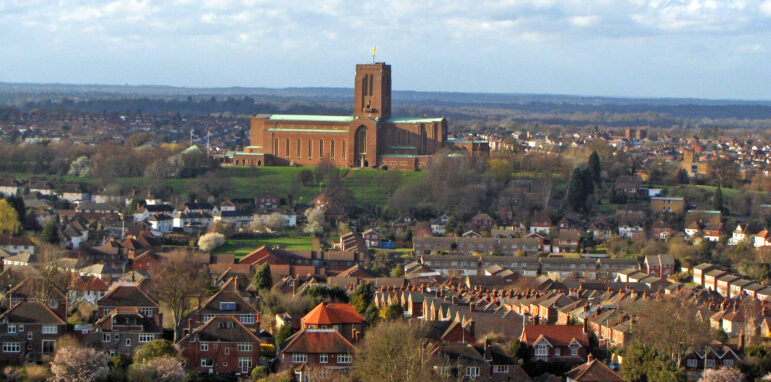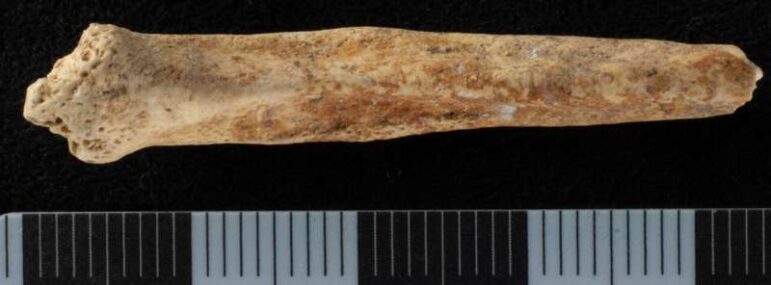LONDON – In 2015, ahead of a development project at the former Animal Husbandry Center of Nescot College in Surrey, southeastern England, archaeologists made a surprising discovery. Beneath the surface lay ancient quarry pits used during the Roman era, dating back to the first century A.D. These pits, once mined for chalk and flint, were later backfilled. One pit, known as “Quarry 1,” yielded a trove of human and animal bones, leading researchers to believe the site played a role in ritualistic activities.
A recent study, published in the Oxford Journal of Archaeology in December 2024, delves into the findings from the Nescot site. Ellen Green, a postgraduate researcher from the University of Reading, led the analysis of the quarry’s contents. According to Green, the pit contained one of the largest recorded collections of human and animal bones from a single Romano-British feature. An estimated 11,400 bone fragments were found, representing at least 282 animals and 21 humans. “The shaft was open for a relatively short amount of time, roughly half a century based on the artifactual evidence,” Green noted. Each of the nine depositional events during the first two phases of backfilling likely involved impressive ceremonies given the sheer number of remains.

Surrey. Image credit: Himar Santana Hernández [Public domain]
Sacrificial Area and Rituals
The sheer volume of remains found in Quarry 1 suggests that the site was a sacrificial area. Although no direct marks on the bones indicate a cause of death, Green explains that typical Roman sacrificial methods, such as throat-slitting or drowning, would not leave evidence on skeletal remains. Among the findings were numerous juvenile and newborn animals, including entire litters of puppies and piglets, as well as several horse foals. The presence of these young animals points to possible fertility rituals.
“Horses and dogs both had associations with fertility and abundance during the Romano-British period,” Green explained. “Small dogs, like those recovered from Nescot, were often linked to mother goddesses in the Roman and Iron Age periods. These deities were frequently depicted with cornucopias, infants, and baskets of fruit, symbolizing fertility in both agricultural and social contexts.”

Dog baculum (penis bone) stained with red ochre. Image via Oxford Journal of Archaeology (2024). DOI: 10.1111/ojoa.12317
The Mysterious Stained Dog Bone
Among the six dog penis bones or bacula, recovered from the site, one stood out due to its unusual red-brown staining. Analysis using portable X-ray fluorescence (pXRF) identified the pigment as iron oxide, likely derived from red ochre. Interestingly, no red ochre was present in the soil at the Nescot site, suggesting the bone was stained before burial. The staining was concentrated on the dorsal surface, leading researchers to hypothesize that either the pigment was applied directly or the bone had been wrapped in a dyed cloth that later decomposed.
“There are no other published examples of ochre-stained bones from Roman or Iron Age Britain,” Green stated. “Given the context of its recovery, it seems probable that this bone represents a ritual item. A penis bone has obvious symbolic connotations, particularly considering the strong association between dogs and fertility in Roman Britain.”
Seasonal Clues and Agricultural Connections
The deposition of juvenile animals provides insights into the seasonality of the rituals. Most of the sacrificed animals were perinatal, meaning they were likely born in spring or early summer. This aligns with Roman practices of breeding horses between the vernal equinox and summer solstice, resulting in foals being born from late February to late May. Similarly, lambs and kids, which were also found at the site, tend to be born during the same period.
The timing of these sacrificial events coincides with the agricultural planting season for barley and other cereals, suggesting a possible link to agricultural fertility. The original use of the quarry further supports this theory. The Nescot quarry pits were initially excavated for chalk and flint. Chalk, in particular, may have been used as a fertilizer, as suggested by Roman sources. Pliny the Elder, a Roman author, described the practice of digging deep chalk shafts in Britannia for agricultural purposes.
Interpreting Ritual Significance
While it is difficult to determine the exact reasons behind the deposition of approximately 300 humans and animals in the disused quarry over half a century, the evidence points to rituals centered on abundance, fertility, and the agricultural cycle. “Why will always be the most difficult question for archaeology,” Green wrote. “However, by integrating various strands of evidence—from the types of animals deposited to the seasonality of their remains—a convincing narrative emerges.”
The study highlights how a seemingly grim feature filled with bones can symbolize new life and regeneration. Though ritual shafts linked to fertility are not a new concept, this research is among the first to draw linked different strands of evidence, moving beyond outdated stereotypes of Celtic rituals.
“While the idea of ritual shafts being associated with fertility is not new, this study is one of the first to use multiple types of evidence to back up this idea.” Green concluded, “A feature full of the dead becomes a potential symbol of new life, adding another layer to the complex tapestry of Romano-British beliefs.”
The Wild Hunt is not responsible for links to external content.
To join a conversation on this post:
Visit our The Wild Hunt subreddit! Point your favorite browser to https://www.reddit.com/r/The_Wild_Hunt_News/, then click “JOIN”. Make sure to click the bell, too, to be notified of new articles posted to our subreddit.
